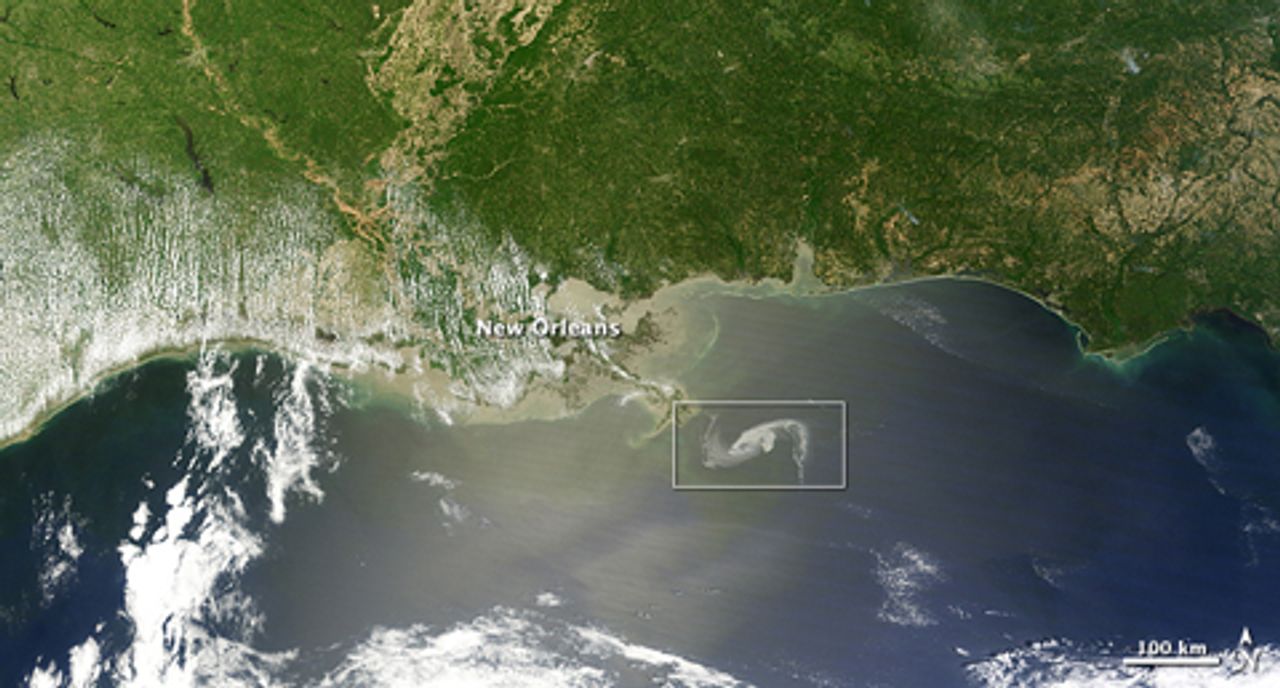The oil spill in the Gulf of Mexico is turning into one of the worst environmental disasters in US history, likely devastating local economies throughout the region and potentially the East Coast of the United States. Efforts to contain the spill have so far been ineffective, hindered by poor weather, while capping the leak at its source could take months.
 Gulf Oil Spill April 30 (NASA)
Gulf Oil Spill April 30 (NASA)The Obama administration is scrambling to respond after more than a week of inaction. Obama visited the region on Sunday, and the administration dispatched cabinet officials to defend its response on Sunday morning talk shows. However, it is clear that the government has no plan in place for dealing with the disaster.
Eleven workers were killed April 20 in the catastrophic explosion on the Deepwater Horizon oil rig, about 50 miles off the cost of Louisiana. The rig was leased by British-based oil company BP.
The oil slick produced by the leaking well is already approaching the wetlands and coast of Louisiana, and will be pushed further towards the shore by storms in the region. It is expected to hit Alabama and Mississippi by Monday.
The New Orleans Times-Picayune commented: ““Terrified. It was the most common expression across the southeast Louisiana fishing community this week as the river of oil from a blown-out rig on the Gulf of Mexico began flowing onto the coast in what officials say could be a two- to three-month flood of toxic chemicals and sticky tars.”
About 1 in 17 jobs in the region are directly in the fishing industry, and many more jobs are heavily dependent on it. In Louisiana, commercial fishing is a $2.5-billion a year industry, and could be virtually shutdown.
Environmental damage could be particularly severe because of the type of oil involved in the spill. Because it is being tapped from reserves deep under the ocean surface, the oil from Deepwater Horizon is heavier and more damaging than other varieties in the region.
Estimates of the amount of leaking oil vary widely, and there is a possibility of a vast expansion in the coming weeks. The floating oil rig has sunk, leaving the pipe that connected it to the well 5,000 feet below crumpled and leaking. After first claiming there was no leak, then that 1,000 barrels (42,000 gallons) were escaping every day, BP and government officials now say that the rate is closer to 5,000 barrels (210,000 gallons) a day.
Other scientists suggest that the oil leak is far worse than the government’s high estimate. Based on an analysis of US Coast Guard maps, Ian MacDonald, an oceanographer at Florida State University, estimated on April 28 that the amount of oil released was more than 8.9 million gallons, yielding a spill rate of about 26,000 barrels (more than 1 million gallons) a day.
SkyTruth, a non-profit environmental analysis firm, estimated that by Sunday more than 12.2 million gallons had spilled into the Gulf.
If these higher figures are correct, the oil spill already exceeds the amount released by the Exxon Valdez oil tanker in 1989 (about 11 million gallons).
“The government and BP are trying to make their estimates based on what they see coming out from the sea floor,” John Amos, president of SkyTruth told the World Socialist Web Site. “It is very difficult to do this with any accuracy. Our approach is different, based on the size and the appearance of the oil on the surface.”
The slick has grown rapidly over the past several days, and now covers an area about the size of Puerto Rico.
“The spill and the spreading is getting so much faster and expanding much quicker than they estimated,” Hans Graber, executive director of the University of Miami’s Center for Southeastern Tropical Advanced Remote Sensing, told the Associated Press.
Graber said that one major concern was that the slick would intersect with the Gulf Stream and be carried around the tip of Florida and up the East Coast of the US. “It will be on the East Coast of Florida in almost no time,” he said. “I don’t think we can prevent that. It’s more a question of when rather than if.”
In a worst-case scenario, the entire pipe could collapse, vastly increasing the size of the leak. The AP cited Louisiana State University professor Ed Overton: “When these things go, they go KABOOM. If this thing does collapse, we’ve got a big, big blow”—as much as 100,000 barrels a day.
Efforts to contain the slick by booms or disperse it using chemicals have proved largely ineffective and have been undercut by poor weather conditions. Any solution requires capping the leak at its source. However, neither the government nor BP has in place mechanisms for doing this quickly.
The device that is supposed to block flow from the well—the blowout preventer (BOP)—failed and is not responding to efforts to force it shut.
Two options remain. One would place giant receptacles over the well, trapping the oil and piping it up to ships for collection. This method has never been tried at depths comparable to the drilling location. Moreover, the receptacles are still being built and may take weeks to deploy.
Another option is to drill a separate well nearby and connect it ho rizontally with the existing well, which could be filled with cement to plug the leak. This method has also not been tried at such depths, and will take up to three months to implement.
At this rate, several tens of millions of gallons of oil could be released by the time the leak is shut off. In the worst case scenario, the oil will continue to spill out until the entire reserve is drained. BP has not provided estimates for how much oil this could involve, but the reserve is estimated to have a capacity of tens of millions of gallons.
